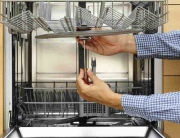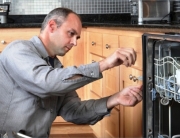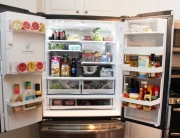A lot of what you think you know about taking care of your dishwasher, fridge, oven and stove is wrong. Here are some common problems — and how to fix them.
If you maintain your appliances properly, you can help extend their lifespan, improve energy efficiency and cut down on costly repair bills. But there are a lot of myths floating around about the proper way to maintain your fridge, dishwasher, oven and other kitchen appliances. The pros at Sears Home Services separate fact from fiction.
Kitchen Myth #1: Only The Inside Of My Refrigerator Needs Cleaning
Cleaning the outside is more vital to the life of your fridge, specifically the condenser coils. But don’t worry — it’s not a big job and it won’t take long. You should be cleaning the dust off of the coils once or twice a year, he says.
Back in the day, it was easier to maintain your fridge and clean these coils because they were on the top or the back of the fridge. A couple of sweeps and you were done. Today’s newer models tend to have the condensers on the bottom, which can make them tougher to get to. The solution: a refrigerator brush that’s specifically designed for cleaning your fridge’s coils. It’s a long, narrow, stiff brush that you can find at many hardware stores. The energy you save by cleaning the coil will pay for the cost of the brush in no time.
Kitchen Myth #2: My dishwasher will be fine if I am away for weeks
When you leave your home for an extended period of time, especially in the winter months, it’s useful to turn off your dishwasher. If the dishwasher will be sitting for more than a month or will be exposed to temperatures below freezing, the hoses could dry out or freeze up.
Here’s how you can prevent this. Have a qualified person do the following:
- Turn off electrical power to the dishwasher at the supply source by removing fuses or tripping the circuit breaker.
- Shut off the water supply.
- Place a pan under the inlet valve.
- Disconnect the water line from the inlet valve and drain into the pan.
- Disconnect the drain line from the pump and drain the water into the pan.
When you return home, to restore service, have a qualified person:
- Reconnect the water, drain and electrical power supply.
- Turn on the water and electrical power supply.
- Fill both detergent cups and run the dishwasher through the heavy soil cycle on your dishwasher (typically labeled “Pots & Pans” or “Heavy Wash”).
- Check connections to make sure they don’t leak.
Kitchen Myth #3: The self-cleaning cycle enough to clean the oven
The self-cleaning cycle is great for cleaning the inside of your oven, but for optimal oven maintenance, clean the vent filter regularly, too, or replace it once a year. Cleaning the vent hood filter above the range will help in keeping a buildup of grease from the area around the range and the range’s cooktop, which will make it easier to keep the range clean. For the self-cleaning cycle, be sure to run it whenever the oven cavity gets soiled. Montgomery recommends that large spills be wiped up before starting the clean cycle.
If your appliance doesn’t have this cycle, use spray oven cleaner and some good old-fashioned elbow grease to clean the oven cavity.
Kitchen Myth #4: Oven Cleaner Works Well On The Stove Top
Simply said, no, you can’t. If you have a glass cooktop, it’s vital you clean it properly to prevent scratches and other damage. Montgomery explains what to do, and what not to do, to care for your glass cooktop.
Never use any of the following to clean a glass cooktop:
- Abrasive cleansers
- Metal or nylon scouring pad
- Chlorine bleach
- Ammonia
- Glass cleaner
- Oven cleaner
- Dirty sponge or cloth
How to properly clean a glass cooktop:
- Remove large spills.
- Apply cooktop cleaner.
- Let the cleaner stand for a few minutes.
- Scrub with a non-abrasive pad.
- Once clean, remove excess cleaner with a clean, soft cloth.
If you have any questions, please give us a call at Appliance Guard – (310) 318-3538






























Recent Comments